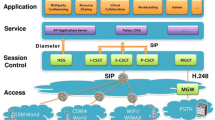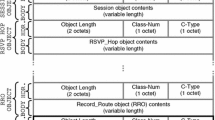Abstract
IMS (IP multimedia subsystem) is a key technology, to enable NSPs (network service providers) to provide various services over IP-based networks. In order for NSPs to provide stable network services, it is important to realize QoS in the transport stratum. RACF (Resource and admission control functions) has being standardized to perform admission control from the demands of users. However, the admission control of RACF for MPLS (Multiprotocol label switching) requires high functionality in the routers (e.g., monitor traffic and traffic shaping in each LSP [Label switched paths]) and gives large impact on the operation of NSPs. By utilizing the information which IMS function provides and basic MPLS function, we propose the feasible traffic management which distributes the traffic of specific class over multiple LSPs (Label switched paths) in the consideration of the traffic accommodation. Our evaluation shows that the proposed method distributing the traffic over two LSPs has enough effect.
Similar content being viewed by others
References
ITU-T Y.2001 (2004). General overview of NGN.
3GPP TS 23.228 (2005). IP multimedia subsystem (IMS), Stage 2.
ETSI ES 283 003, V1.1.1 (2001). Telecommunications and Internet converged services and protocols for advanced networking (TISPAN); IP multimedia call control protocol based on session initiation protocol (SIP) and session description protocol (SDP), Stage 3.
Rosenberg, J., Schulzrinne, H., Camarillo, G., Johnson, A., & Peterson, J. (2002). Session initial protocol. IETF RFC3261.
ITU-T Y.2111 (2006). Resource and admission control functions in next generation networks.
Rosen, E., Viswanathan, A., & Callon, R. (2001). Multiprotocol label switching architecture. IETF RFC3031.
Jung, J. J. (2011). Service chain-based business alliance formation in service-oriented architecture. Expert Systems With Applications, 38(3), 2206–2211.
Jung, J. J. (2009). Knowledge distribution via shared context between blog-based knowledge management systems: a case study of collaborative tagging. Expert Systems With Applications, 36(7), 10627–10633.
Jung, J. J. (2010). Reusing ontology mappings for query segmentation and routing in semantic peer-to-peer environment. Information Sciences, 180(17), 3248–3257.
Awduche, D., Malcolm, J., & Agogbua, J. (1999). Requirements for traffic engineering over MPLS. IETF RFC2702.
Awduche, D., Berger, L., Gan, D., Li, T., Srinivasan, V., & Swallow, G. (2001). RSVP-TE: extensions to RSVP for LSP tunnels. IETF RFC3209.
Le Faucheur, F., & Lai, W. (2003). Requirements for support of differentiated service aware MPLS traffic engineering. IETF RFC3564.
Alvarez, S. (2006). QoS for IP/MPLS networks. Cisco: Cisco Press.
Ishi, H., & Nagami, K. (2004). Proposal and evaluation for Automatic bandwidth setting in MPLS LSP. IEICE Transactions on Communications, J89-B(10), 1894–1901.
Nicols, K., Blake, S., & Baker, F. (1998). Definition of the differentiated services field (DS field) in the IPv4 and IPv6 headers. IETF RFC2474.
ITU-T Y.2174 (2008). Distributed RACF architecture for MPLS networks.
Martini, B., Baronceli, F., Martini, V., Torkman, K., & Castoldi, P. (2009). ITU-T RACF implementation for application-driven QoS control in MPLS networks. In Proceedings of the IFIP/IEEE international symposium on integrated network management (p. 422–429).
Srinvasan, C., & Bloomberg, L. P. (2004). Multiprotocol label switching (MPLS) traffic engineering (TE) management information base (MIB). IETF RFC3812.
Medina, A., & Matta, I. (2000). BRITE: A flexible generator of Internet topologies (Technical Report, BU-CS-TR-2000-005). Boston University, Boston, MA.
Albert, R., & Barabasi, A. (2002). Statistical mechanics of complex networks. Reviews of Modern Physics, 74, 47–97.
3GPP2 X.S0013-007-A (2005). All-IP core network multimedia domain.
Tamura, H., Kawahara, K., & Oie, Y. (2004). Analysis of two-phase path management scheme for MPLS traffic engineering. In Proceedings of SPIE performance quality of service, and control of next generation communication networks (pp. 194–203).
Zaghloul, S., Jukan, A., & Alanqar, W. (2007). Extending QoS from radio access to an All-IP core in 3G networks: an operator’s perspective. IEEE Communications Magazine, 45(9), 124–132.
Wegscheider, F. (2006). Minimizing unnecessary notification traffic in IMS presence system. In Proceedings of the 1st international symposium on wireless pervasive computing (pp. 6–12).
Author information
Authors and Affiliations
Corresponding author
Rights and permissions
About this article
Cite this article
Usui, T., Kitatsuji, Y. & Yokota, H. A study on traffic management cooperating with IMS in MPLS networks. Telecommun Syst 52, 671–680 (2013). https://doi.org/10.1007/s11235-011-9511-7
Published:
Issue Date:
DOI: https://doi.org/10.1007/s11235-011-9511-7




